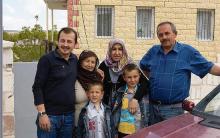GMCC "Integration" (Moscow State Budgetary Institution of Culture) State Museum - Cultural Center"Integration" named after N.A. Ostrovsky) is a center under the Moscow Department of Culture (founder). The merged institution was created on December 14, 2016.
In the premises at st. Tverskaya, 14 there is a museum in which open permanent exhibition, a hall of changing exhibitions and memorial rooms of the writer N.A. Ostrovsky (there are no restrictions on service consumers).
Areas of work:
- Organization of permanent museum exhibitions;
- Organization of rotating and traveling exhibitions;
- Carrying out cultural events(concerts, plays, performances);
- Methodological support for cultural institutions working with people with disabilities.
In the premises at st. Lazo no. 12 and st. Sayanskaya 6B there are modern cultural centers in which all conditions have been created for the harmonious cultural and aesthetic development of each visitor (there are no restrictions on consumers of services).
Areas of work:
- Classes in creative studios and sports sections(for children, youth, adults and the elderly, photo studio);
- Organizing cultural events (exhibitions, concerts, performances, performances, holidays, birthdays);
- Educational programs for specialists of cultural institutions on the ethics of communication with people with disabilities (project “People IN”);
- Carrying out special projects - concerts and business trainings in the dark;
- City methodological center for the sociocultural integration of people with disabilities into the cultural life of Moscow.
All structural units- cultural institutions for everyone, where all conditions have been created for a comfortable stay for people with disabilities of all ages and categories.
GMCC "Integration" is headed by the Presidential Trustee Russian Federation V.V. Putin 2012 - 2018 Alexey Alexandrovich Volodin.
History of the museum
Museum "Integration" named after. N.A. Ostovsky is located on Tverskaya Street in house No. 14 (a monument of history and culture of the 17th-20th centuries). The mansion on Tverskaya 14 combines three eras, which is reflected in appearance building and its functional purpose. In it in different time lived amazing people who left a special mark on the culture of their time.
IN 1824-1829 Princess Zinaida Alexandrovna Volkonskaya lived in the house. Her literary and musical salon was one of the most famous in Moscow and was attended by A. Pushkin, V. Zhukovsky, E. Baratynsky, D. Venevitinov, A. Delvig, V. Kuchelbecker, V. Odoevsky, F. Tyutchev, Adam Mitskevich , A. Alyabyev, A. Verstovsky.
WITH 1898 to 1917 The building was owned by the famous millionaire merchant G. Eliseev - a significant part of the premises was allocated to a store famous for exotic fruits, the best wines, rare varieties of coffee, tea, and spices. IN Soviet years it was officially called Gastronome No. 1, but old Muscovites always called the store Eliseevsky.
WITH 1918 part of the house was used for apartments. The apartment on Tverskaya, 14 was provided to the writer N.A. Ostrovsky, author of the book “How the Steel Was Tempered.” It consisted of two rooms, which were furnished with official furniture. Many people have been in the apartment famous people: director V. Meyerhold, actress Z. Reich, writers and poets A. Fadeev, A. Karavaeva, N. Aseev, B. Kornilov, A. Serafimovich, M. Svetlov, V. Inber.
IN 1940 a museum named after N.A. was created in the apartment. Ostrovsky. In 1992, the exhibition “Overcoming” was opened, which is dedicated to people with difficult fate who overcame, following the example of N.A. Ostrovsky, his illnesses.
Memorial apartment N.A. Ostrovsky
The exhibition is dedicated to creativity and personal life writer Nikolai Ostrovsky (1904-1936). The writer wrote the Soviet bestseller “How the Steel Was Tempered”, as well as the first part of the novel “Born of the Storm” (according to the author’s idea there should have been three parts). The last novel, the writer wrote in this house. The writer lived a short life, but rich life. Since childhood, he suffered from a disease that took his life so early. For the last 9 years he was so weak that he spent in bed, but continued to work.
The writer is an example of a strong will, the desire to achieve a goal.
In the museum you can find the writer’s documents, photographs, books, and personal belongings. The exhibition displays two rooms in which the writer lived. Furnishings and personal belongings have been preserved.
The museum has been open to visitors since 1940. The house contains an apartment where Nikolai Ostrovsky lived his last years of life. The first director of the museum (1940-1963) was the widow of the writer R.P. Ostrovskaya.
Hall No. 1 and 2: Salon of Princess Z. Volkonskaya
In this house of Zinaida Volkonskaya, literary and musical evenings were held every week - salons, which were visited by celebrities of that time. A.S. has been here several times. Pushkin, who called the princess “the queen of muses and beauty.”
The museum displays a permanent exhibition "From the History of the House".
Hall No. 3: “Overcoming” (the fate of people with disabilities)
The museum also features an exhibition telling about people with disabilities, but who have achieved great results in life.
In the early 1970s, Svyatoslav Richter and Nina Dorliak settled on the sixteenth floor of building 2/6 on Bolshaya Bronnaya Street, not far from the Conservatory. This house is a typical brick tower. But when you go upstairs and enter the apartment, you find yourself in a special world. No luxury, no fuss of things. The character and lifestyle of the owner, the special energy of a person whom Yuri Bashmet calls “a safe-conduct of truth in art” are felt in everything.
In a large room, called the hall in the old days, Richter practiced alone or rehearsed with other musicians. There are two Steinway&sons pianos, two antique Italian floor lamps donated by the mayor of Florence, a tapestry, and paintings. Auditions of operas or viewings of favorite films took place in the hall.
In the office, or, as Richter himself called this room, “the closet,” there are cabinets with books, records, and cassettes. The most valuable thing here is a cabinet with sheet music, on which the maestro’s notes have been preserved. There is also a wooden figurine of the Infant John the Baptist, this is a memory of the Musical Festivals organized by Richter in Touraine in France. On the wall there is a plaster counter-relief with the profile of Boris Pasternak from the monument in Peredelkino - like an imprint, a trace left by a person on the earth, an image wonderfully found by Sarah Lebedeva.
Hanging nearby small landscape Saryan, donated by Elena Sergeevna Bulgakova. The secretary contains the manuscript of Sergei Prokofiev's Ninth Sonata, dedicated to Richter, a photograph of Heinrich Neuhaus, a drawing by Picasso, and Solzhenitsyn's "Little Girls". Such was Richter's social circle.
The “Green Room” is a relaxation room; on concert days it turned into an artistic room. On the wall hangs a portrait of his father, Teofil Danilovich, an elegant, reserved man. He graduated from the Vienna Conservatory as a pianist and composer. Teofil Danilovich and Anna Pavlovna (Svyatoslav’s mother) were unable to leave Odessa in 1941, when Nazi troops were approaching the city. Teofil Danilovich was arrested and executed on the night of November 6–7 as a “German spy.” Anna Pavlovna went to Romania, and then to Germany, leaving Russia forever and only son, who was in Moscow at that time and was also awaiting arrest. They met only 20 years later.
Svyatoslav Richter's artistic interests and passions were varied; he not only loved painting, but was also an artist himself. His pastels are displayed in a small room. In them, Robert Falk noted the “amazing sensation of light.” In Nina Lvovna’s former kitchen there are photographs telling about the musician’s life.
Cultural Center "Integration" named after N. A. Ostrovsky (former name - Humanitarian Center "Overcoming") - unusual museum, dedicated to people, who overcame a terrible illness and left a noticeable mark on history. His exhibition talks about the difficult but real way of overcoming oneself and integrating into society.
Writer Nikolai Ostrovsky is the author of the famous Soviet time novel “How the Steel Was Tempered.” This book about a man’s courageous struggle for his ideals has become a manifesto for several generations. It has been published many times in millions of copies and has been translated into 75 languages. The famous words were uttered in this novel: “The most precious thing a person has is life. It is given to him once, and he must live it in such a way that it does not cause excruciating pain for the years spent aimlessly.” Nikolai Ostrovsky lived 32 years, of which nine years he was bedridden. He became a writer while completely immobile and blind.
Museum activities
In 1824‒1829 Princess Zinaida Volkonskaya, “the queen of muses and beauty,” as Pushkin called her, lived in the mansion. Her literary and musical salon was one of the most famous in Moscow. V. Zhukovsky, E. Baratynsky, A. Delvig, V. Kuchelbecker, V. Odoevsky, F. Tyutchev, A. Mitskevich, A. Alyabyev and many others have been here. It was here in 1826 that a farewell party took place for the wives of the Decembrists, who were leaving for their husbands into exile in Siberia. In 1829, Volkonskaya left for Italy forever. After her departure, the house passed from hand to hand for some time.
The new life of the mansion began in late XIX V. From 1898 to 1917 The building was owned by the famous millionaire merchant G. Eliseev. A significant part of the premises was allocated for a store. Here, in luxurious interiors, exotic fruits, the best wines, rare varieties of coffee, tea, and spices were sold. During the Soviet years, the store continued to operate as Gastronome No. 1, but Muscovites always called it Eliseevsky.
Since 1918, part of the house began to be used as apartments. In 1935‒1936 The writer Nikolai Ostrovsky lived in one of them. On December 22, 1936, N. Ostrovsky passed away. In 1940, a museum was created in the apartment.
2016-2019 moscovery.com










Annexation of the Crimean Khanate to Russia Abolition of duties and the mint
Church of St. Dmitry the Myrrh-Streaming in the field
Group Bible Reading and Study Time of Voluntary Infirmity
Meat with eggplants and tomatoes in the oven Ragu with white wine
How to properly and tasty cook pancakes with cottage cheese